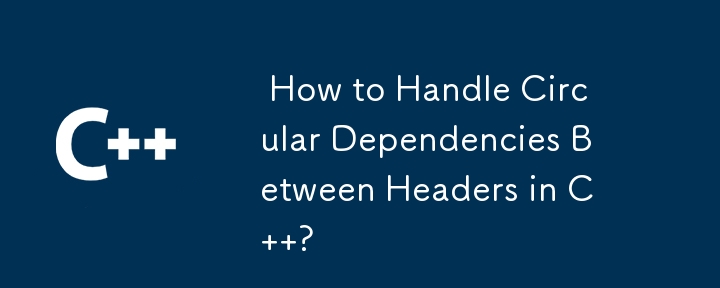如何处理 C++ 中标头之间的循环依赖关系?
发布于2024-11-12

C 中相互包含的标头
在 C 中,有时需要标头相互包含。然而,这可能会导致问题,特别是当涉及到 #include 语句的放置位置时。
内部或外部宏
一般来说,#include 语句应该放置在宏内部,例如#ifndef include Guards。这可以防止编译期间无限递归,如以下示例所示:
// A.h
#ifndef A_H_
#define A_H_
#include "B.h"
class A {
private:
B b;
public:
A() : b(*this) {}
};
#endif // A_H_// B.h
#ifndef B_H_
#define B_H_
#include "A.h"
class B {
private:
A& a;
public:
B(A& a) : a(a) {}
};
#endif // B_H_将 #include 语句放在宏之外会导致编译器由于 A.h 和 B.h 之间的相互包含而无限递归。
未声明类型
但是,将 #include 语句放在宏内可能会导致未声明类型的问题。例如,考虑以下代码:
// A.h
#ifndef A_H_
#define A_H_
class A; // Forward declaration
#include "B.h"
class A {
private:
B b;
public:
A() : b(*this) {}
};
#endif // A_H_// B.h
#ifndef B_H_
#define B_H_
#include "A.h"
class B {
private:
A a; // Directly include A
public:
B(A& a) : a(a) {}
};
#endif // B_H_在这种情况下,编译器会抱怨 A 是 B.h 中未声明的类型。这是因为当包含 B.h 时,A.h 中的前向声明是不可见的。
解决方案:前向声明
要解决这些问题,最好使用前向声明并在必要时包含包含完整定义的标题。在这个例子中,A的前向声明应该添加到B.h中B的定义之前:
// B.h
#ifndef B_H_
#define B_H_
class A; // Forward declaration
#include "A.h"
class B {
private:
A a; // Directly include A
public:
B(A& a) : a(a) {}
};
#endif // B_H_
最新教程
更多>
-
 Bootstrap 4 Beta 中的列偏移发生了什么?Bootstrap 4 Beta:列偏移的删除和恢复Bootstrap 4 在其 Beta 1 版本中引入了重大更改柱子偏移了。然而,随着 Beta 2 的后续发布,这些变化已经逆转。从 offset-md-* 到 ml-auto在 Bootstrap 4 Beta 1 中, offset-md-*...编程 发布于2024-11-16
Bootstrap 4 Beta 中的列偏移发生了什么?Bootstrap 4 Beta:列偏移的删除和恢复Bootstrap 4 在其 Beta 1 版本中引入了重大更改柱子偏移了。然而,随着 Beta 2 的后续发布,这些变化已经逆转。从 offset-md-* 到 ml-auto在 Bootstrap 4 Beta 1 中, offset-md-*...编程 发布于2024-11-16 -
 如何修复 macOS 上 Django 中的“配置不正确:加载 MySQLdb 模块时出错”?MySQL配置不正确:相对路径的问题在Django中运行python manage.py runserver时,可能会遇到以下错误:ImproperlyConfigured: Error loading MySQLdb module: dlopen(/Library/Python/2.7/site-...编程 发布于2024-11-16
如何修复 macOS 上 Django 中的“配置不正确:加载 MySQLdb 模块时出错”?MySQL配置不正确:相对路径的问题在Django中运行python manage.py runserver时,可能会遇到以下错误:ImproperlyConfigured: Error loading MySQLdb module: dlopen(/Library/Python/2.7/site-...编程 发布于2024-11-16 -
 如何使用 MySQL 查找今天生日的用户?如何使用 MySQL 识别今天生日的用户使用 MySQL 确定今天是否是用户的生日涉及查找生日匹配的所有行今天的日期。这可以通过一个简单的 MySQL 查询来实现,该查询将存储为 UNIX 时间戳的生日与今天的日期进行比较。以下 SQL 查询将获取今天有生日的所有用户: FROM USERS ...编程 发布于2024-11-16
如何使用 MySQL 查找今天生日的用户?如何使用 MySQL 识别今天生日的用户使用 MySQL 确定今天是否是用户的生日涉及查找生日匹配的所有行今天的日期。这可以通过一个简单的 MySQL 查询来实现,该查询将存储为 UNIX 时间戳的生日与今天的日期进行比较。以下 SQL 查询将获取今天有生日的所有用户: FROM USERS ...编程 发布于2024-11-16 -
 除了“if”语句之外:还有什么地方可以在不进行强制转换的情况下使用具有显式“bool”转换的类型?无需强制转换即可上下文转换为 bool您的类定义了对 bool 的显式转换,使您能够在条件语句中直接使用其实例“t”。然而,这种显式转换提出了一个问题:“t”在哪里可以在不进行强制转换的情况下用作 bool?上下文转换场景C 标准指定了四种值可以根据上下文转换为 bool 的主要场景:语句:if、w...编程 发布于2024-11-16
除了“if”语句之外:还有什么地方可以在不进行强制转换的情况下使用具有显式“bool”转换的类型?无需强制转换即可上下文转换为 bool您的类定义了对 bool 的显式转换,使您能够在条件语句中直接使用其实例“t”。然而,这种显式转换提出了一个问题:“t”在哪里可以在不进行强制转换的情况下用作 bool?上下文转换场景C 标准指定了四种值可以根据上下文转换为 bool 的主要场景:语句:if、w...编程 发布于2024-11-16 -
 在 Go 中使用 WebSocket 进行实时通信构建需要实时更新的应用程序(例如聊天应用程序、实时通知或协作工具)需要一种比传统 HTTP 更快、更具交互性的通信方法。这就是 WebSockets 发挥作用的地方!今天,我们将探讨如何在 Go 中使用 WebSocket,以便您可以向应用程序添加实时功能。 在这篇文章中,我们将介绍: WebSoc...编程 发布于2024-11-16
在 Go 中使用 WebSocket 进行实时通信构建需要实时更新的应用程序(例如聊天应用程序、实时通知或协作工具)需要一种比传统 HTTP 更快、更具交互性的通信方法。这就是 WebSockets 发挥作用的地方!今天,我们将探讨如何在 Go 中使用 WebSocket,以便您可以向应用程序添加实时功能。 在这篇文章中,我们将介绍: WebSoc...编程 发布于2024-11-16 -
 如何在 PHP 中组合两个关联数组,同时保留唯一 ID 并处理重复名称?在 PHP 中组合关联数组在 PHP 中,将两个关联数组组合成一个数组是一项常见任务。考虑以下请求:问题描述:提供的代码定义了两个关联数组,$array1和$array2。目标是创建一个新数组 $array3,它合并两个数组中的所有键值对。 此外,提供的数组具有唯一的 ID,而名称可能重合。要求是构...编程 发布于2024-11-16
如何在 PHP 中组合两个关联数组,同时保留唯一 ID 并处理重复名称?在 PHP 中组合关联数组在 PHP 中,将两个关联数组组合成一个数组是一项常见任务。考虑以下请求:问题描述:提供的代码定义了两个关联数组,$array1和$array2。目标是创建一个新数组 $array3,它合并两个数组中的所有键值对。 此外,提供的数组具有唯一的 ID,而名称可能重合。要求是构...编程 发布于2024-11-16 -
 为什么 Visual Studio 2010 中 x86 和 x64 的浮点运算不同?x86 和 x64 之间的浮点算术差异在 Visual Studio 2010 中,x86 和 x64 版本之间的浮点算术存在明显差异当比较某些表达式的值时出现。这种差异体现在以下代码中:float a = 50.0f; float b = 65.0f; float c = 1.3f; float ...编程 发布于2024-11-15
为什么 Visual Studio 2010 中 x86 和 x64 的浮点运算不同?x86 和 x64 之间的浮点算术差异在 Visual Studio 2010 中,x86 和 x64 版本之间的浮点算术存在明显差异当比较某些表达式的值时出现。这种差异体现在以下代码中:float a = 50.0f; float b = 65.0f; float c = 1.3f; float ...编程 发布于2024-11-15 -
 如何提高带有通配符的 MySQL LIKE 运算符的性能?MySQL LIKE 运算符优化问题:使用通配符(例如 '%test% ')?答案: 是的,在查询中使用特定模式时,MySQL 可以优化 LIKE 运算符的性能。前缀通配符: 如果您的查询类似于 foo LIKE 'abc%' 或 foo LIKE 'abc�...编程 发布于2024-11-15
如何提高带有通配符的 MySQL LIKE 运算符的性能?MySQL LIKE 运算符优化问题:使用通配符(例如 '%test% ')?答案: 是的,在查询中使用特定模式时,MySQL 可以优化 LIKE 运算符的性能。前缀通配符: 如果您的查询类似于 foo LIKE 'abc%' 或 foo LIKE 'abc�...编程 发布于2024-11-15 -
 如何使用 PHP 通过 POST 向外部网站发送数据?在 PHP 中通过 POST 重定向和发送数据在 PHP 中,您可能会遇到需要将用户重定向到外部的情况网站并通过 POST 将数据传递到该网站。与 HTML 表单不同,PHP 本身并不支持此行为。GET 与 POST在 Web 开发中,有两种主要方法用于从源发送数据到目的地:GET:数据作为查询参数...编程 发布于2024-11-15
如何使用 PHP 通过 POST 向外部网站发送数据?在 PHP 中通过 POST 重定向和发送数据在 PHP 中,您可能会遇到需要将用户重定向到外部的情况网站并通过 POST 将数据传递到该网站。与 HTML 表单不同,PHP 本身并不支持此行为。GET 与 POST在 Web 开发中,有两种主要方法用于从源发送数据到目的地:GET:数据作为查询参数...编程 发布于2024-11-15 -
 如何使用 GCC 捕获 Linux 中的分段错误?捕获 Linux 中的分段错误问:我在第三方库中遇到分段错误,但我无法解决根本问题。是否有跨平台或特定于平台的解决方案来使用 gcc 捕获 Linux 中的这些错误?A:Linux 允许将分段错误作为异常处理。当程序遇到此类故障时,它会收到 SIGSEGV 信号。通过设置信号处理程序,您可以拦截此信...编程 发布于2024-11-15
如何使用 GCC 捕获 Linux 中的分段错误?捕获 Linux 中的分段错误问:我在第三方库中遇到分段错误,但我无法解决根本问题。是否有跨平台或特定于平台的解决方案来使用 gcc 捕获 Linux 中的这些错误?A:Linux 允许将分段错误作为异常处理。当程序遇到此类故障时,它会收到 SIGSEGV 信号。通过设置信号处理程序,您可以拦截此信...编程 发布于2024-11-15 -
 如何在不创建实例的情况下访问Go结构体的类型?在不创建物理结构的情况下访问 Reflect.Type在 Go 中,动态加载问题的解决方案需要访问结构的类型,而无需物理创建它们。虽然现有的解决方案要求在类型注册之前创建结构体并清零,但存在一种更有效的方法。人们可以利用 reflect.TypeOf((*Struct)(nil)).Elem()手术...编程 发布于2024-11-15
如何在不创建实例的情况下访问Go结构体的类型?在不创建物理结构的情况下访问 Reflect.Type在 Go 中,动态加载问题的解决方案需要访问结构的类型,而无需物理创建它们。虽然现有的解决方案要求在类型注册之前创建结构体并清零,但存在一种更有效的方法。人们可以利用 reflect.TypeOf((*Struct)(nil)).Elem()手术...编程 发布于2024-11-15 -
 Java中如何高效地将整数转换为字节数组?Java 中整数到字节数组的高效转换将整数转换为字节数组可用于多种目的,例如网络传输或数据存储。有多种方法可以实现此转换。ByteBuffer 类:一种有效的方法是使用 ByteBuffer 类。 ByteBuffer 是一个存储二进制数据并提供各种操作来操纵它的缓冲区。使用 ByteBuffer ...编程 发布于2024-11-15
Java中如何高效地将整数转换为字节数组?Java 中整数到字节数组的高效转换将整数转换为字节数组可用于多种目的,例如网络传输或数据存储。有多种方法可以实现此转换。ByteBuffer 类:一种有效的方法是使用 ByteBuffer 类。 ByteBuffer 是一个存储二进制数据并提供各种操作来操纵它的缓冲区。使用 ByteBuffer ...编程 发布于2024-11-15 -
 如何在 Go 中按多个字段对结构体切片进行排序?按多个字段对切片对象进行排序按多个条件排序考虑以下 Parent 和 Child 结构:type Parent struct { id string children []Child } type Child struct { id string }假设我们有一个...编程 发布于2024-11-15
如何在 Go 中按多个字段对结构体切片进行排序?按多个字段对切片对象进行排序按多个条件排序考虑以下 Parent 和 Child 结构:type Parent struct { id string children []Child } type Child struct { id string }假设我们有一个...编程 发布于2024-11-15 -
 Qt 线程与 Python 线程:我应该在 PyQt 应用程序中使用哪个?PyQt 应用程序中的线程:Qt 线程与 Python 线程寻求使用 PyQt 创建响应式 GUI 应用程序的开发人员经常遇到执行的挑战长时间运行的任务而不影响 UI 的功能。一种解决方案是使用单独的线程来完成这些任务。这就提出了是使用 Qt 线程还是原生 Python 线程模块的问题。Qt 线程提...编程 发布于2024-11-15
Qt 线程与 Python 线程:我应该在 PyQt 应用程序中使用哪个?PyQt 应用程序中的线程:Qt 线程与 Python 线程寻求使用 PyQt 创建响应式 GUI 应用程序的开发人员经常遇到执行的挑战长时间运行的任务而不影响 UI 的功能。一种解决方案是使用单独的线程来完成这些任务。这就提出了是使用 Qt 线程还是原生 Python 线程模块的问题。Qt 线程提...编程 发布于2024-11-15
学习中文
- 1 走路用中文怎么说?走路中文发音,走路中文学习
- 2 坐飞机用中文怎么说?坐飞机中文发音,坐飞机中文学习
- 3 坐火车用中文怎么说?坐火车中文发音,坐火车中文学习
- 4 坐车用中文怎么说?坐车中文发音,坐车中文学习
- 5 开车用中文怎么说?开车中文发音,开车中文学习
- 6 游泳用中文怎么说?游泳中文发音,游泳中文学习
- 7 骑自行车用中文怎么说?骑自行车中文发音,骑自行车中文学习
- 8 你好用中文怎么说?你好中文发音,你好中文学习
- 9 谢谢用中文怎么说?谢谢中文发音,谢谢中文学习
- 10 How to say goodbye in Chinese? 再见Chinese pronunciation, 再见Chinese learning

























